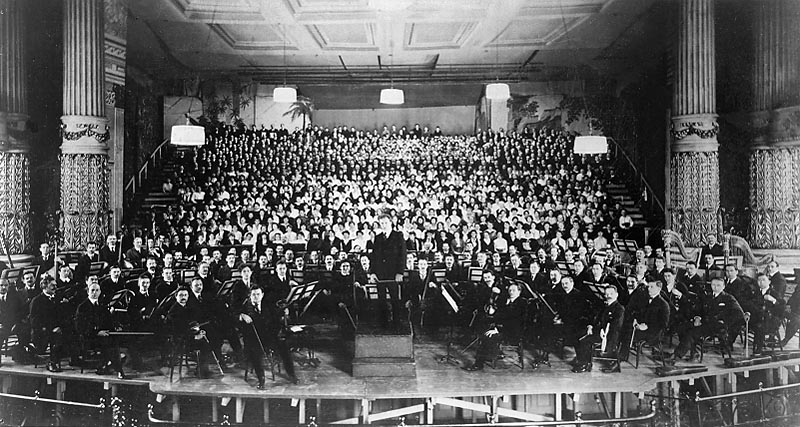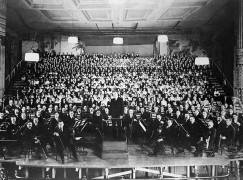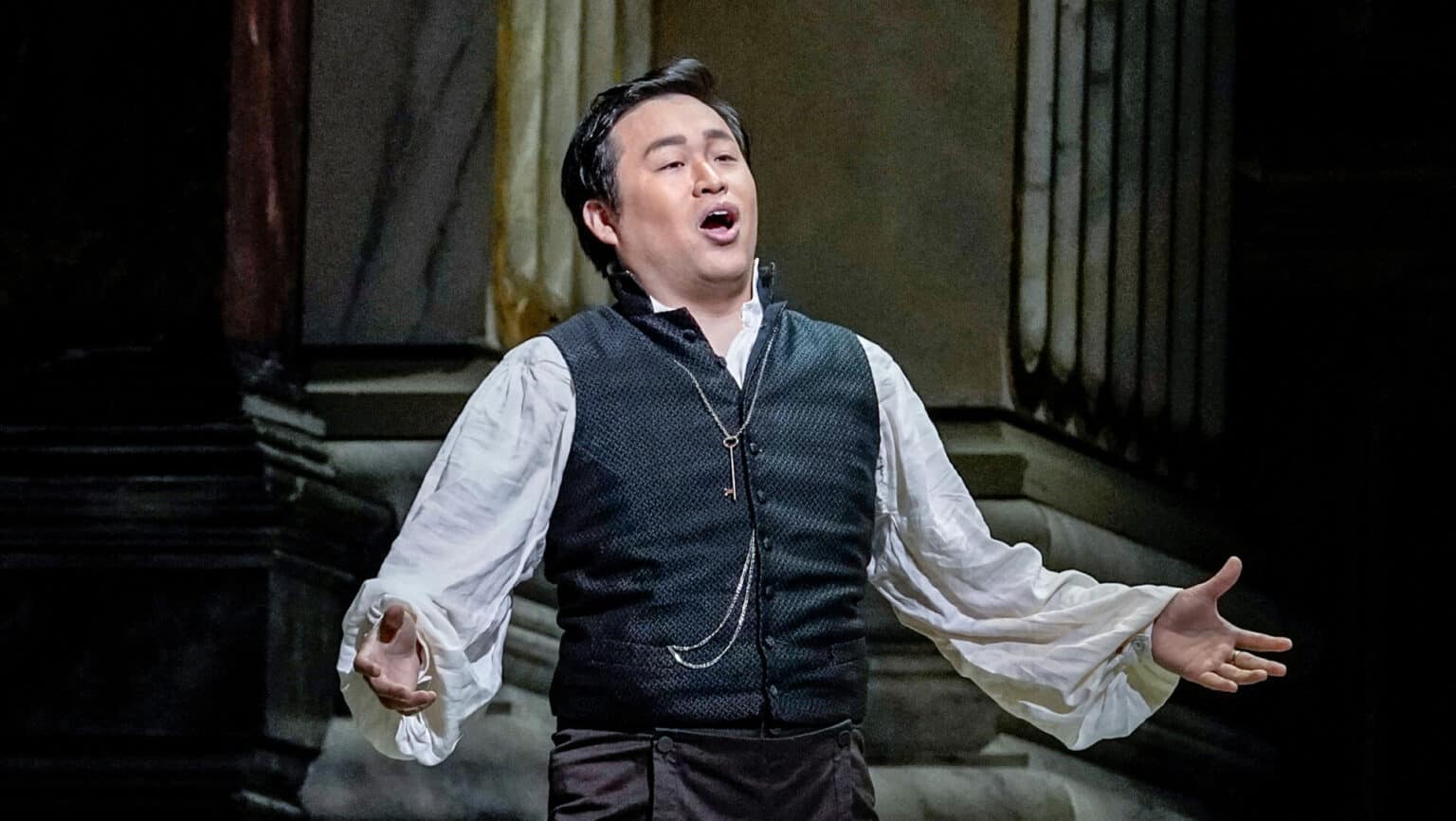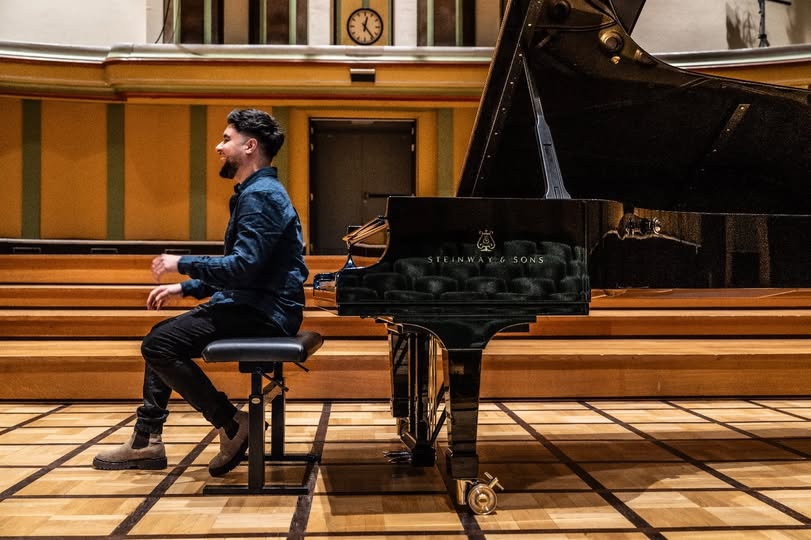Mahler 8 reaches South Dakota
mainPress release:
Sioux Falls, S.D. – The South Dakota Symphony Orchestra (SDSO) reaches a historical milestone with two performances of Mahler’s 8th Symphony, the “Symphony of a Thousand,” April 27-28 at the Washington Pavilion.
Gustav Mahler’s Symphony No. 8, dubbed the “Symphony of a Thousand,” is a massive work lauded as one of the greatest achievements in standard classical concert repertoire. While its first performance in Munich in 1910 brought together over 1,000 performers, the April 27 & 28 performances will have over 350 performers from across South Dakota on the Mary W. Sommervold stage, including:
· South Dakota Symphony Orchestra
· South Dakota Symphony Chorus
· South Dakota State University Chorus
· Black Hills State University Chorus
· Sioux Falls Children’s Choir
· Eight vocal soloists from across the country
Music Director Delta David Gier and the SDSO have performed the Mahler cycle over the last fourteen years. “Every orchestra plays through cycles of Beethoven, Brahms, and Tchaikovsky; these works are our bread and butter and we’ll continue to play them. Few orchestras are able to play Mahler because of the scale and difficulty of his works, and even fewer can play through the entire of Mahler symphonies,” said Gier. “It has required much of us as an organization because of the commitment it has taken from our musicians, staff, and board of directors to climb this Everest of our art form.
“The orchestra members have looked forward to the Mahler symphonies each season because these works are so emotionally and technically challenging, yet immensely gratifying to play and to share with our enthusiastic audience,” said Gier. “Mahler himself considered to be his greatest work. This is his Beethoven 9th Symphony, his monumental achievement.”
The Saturday performance, sponsored by Charles and Barbara Yelverton, is April 27 at 7:30 PM. The Sunday matinee, sponsored by Gerry Berger Law, is April 28 at 2:30 PM. Both performances are held at the Washington Pavilion.

Stokowski’s 1916 US premiere of Mahler 8






Great achievement….. to get all those forces together, and to rehearse them, is quite a challenge. But I always felt that the ‘greatness’ of that symphony is in the ‘bigness’ of it and the ambitious meaning of the whole, rather than in the musical substance of the work, which could basically also be realised in a regular size performance body. Great and big are two different things. Much of the music sounds like a pumped-up Mendelssohn oratorium, a classicism on steroids but without the music to match the ambition and size. The Mahler of, say, symph 1, 4, 5 or 9 is so much more effective. And what to think of the incredible substance of the 1st mvt of nr 9? With all its noise, nr 8 cannot stand in its shadow, not to speak of nr 4 which is ‘small scale’ but great and substantial music, in all its quasi-lightness. Mahler’s ambitions seem to have led him to sometimes undertake endeavors maybe a bit beyond even his powers. But on the other hand, taking risks and leaps of faith also leads to the most surprising creations. Nr 8 does not seem to be in that category, and its performance seems to be more about olympics than music.
Totally agree, John. The 8th shouts when it should be speaking…
Indeed, and in the 1st mvt there is some obviously clumsy voice leading which sounds as if written-down in great haste (Alma calling for dinner).
John, you should have quit after your first sentence. This is about a plains state orchestra out of the mainstream boldly attempting something on quite a great scale bringing together several musical organizations working in concert. I rather think they will have a great time notwithstanding your views of this or any symphony of Gustav Mahler. Actually, I’m guessing they will absolutely love the piece.
I have sung in the chorus of the Mahler 8th a couple of times in my past. It is a mammoth yet totally fulfilling undertaking. Break a leg!!!!!
Good for them. I’ve never heard them but the standard of orchestral playing being what it is these days, I’m sure they’re very much up to the task.
I wish I could share your optimism, but I’ve seen one too many underwhelming performances of Mahler symphonies “out in the provinces.” Some of them have been downright embarrassing.
Mahler is kind of the “holy grail” for conductors, most of whom study the scores to the symphonies when they’re in school. It’s only natural that they’d want the chance to program them wherever they may land … but that doesn’t mean they should.
I agree, Geir is an Assistant Conductor of the New York Phil. He has worked very hard to get through the Mahler symphonies in South Dakota. The winds and brass playing is OK, the local strings are pumped up with the addition of personnel from the Twin Cities, but the quality remains iffy. The choruses should be among the highlights of this but…
Overall I see this performance as a nice addition to Geir’s resume.
Perhaps they don’t care about your views, and if they miss a few moments, they will still have a stupendous musical experience, and some full houses of people will hear a piece they would never have otherwise been able to hear.
I happen to know one of the recent music directors of this orchestra and they are actually quite a good ensemble.
Your skepticism may be understandable, but over the past 40 years I’ve watch the SD Symphony Orchestra grow from Good to Great! Mahler 8 may challenge them, but I haven’t the smallest doubt that they will meet the challenge. They have a first-rate conductor, a first-rate concert hall, and a core of first-rate professional musicians who lead the rest of the talented, dedicated group to unexpectedly thrilling performances. I can’t wait to hear this concert!
The SDSO is an excellent, 2nd-tier group. The conductor is terrific – inspiring. Yes, I’ve heard some lame Mahler out in the sticks. But then I’ve heard wonderful performances no. 2 in Cheyenne and Lubbock, a surprisingly good 7th in Santa Fe, and in Tucson performances of 5, 6 and Das Lied that were as good as anything I’ve ever heard in Los Angeles, New York, London, or elsewhere. The quality of minor orchestras these days is astonishing.
There is a certain irony in the arrogance of your statement, View. That the Faustian section has the divine feminine representing creativity, calling it, owning it, is not lost here.
Is not the performance of a symphony itself a representation of creativity? Of community, in the larger sense?
The shows this weekend were brilliant and went far beyond checking the box of completing the Mahler cycle. The passion was palpable. The soloists, divine. The intensity of the chorus in their pianissimo, breathtaking, as was the finale — literally. For me, the Holy Spirit was indeed invoked, tying the performance together.
Dude. This was no provincial performance. There was true Glory in Sioux Falls last weekend.
Sometimes the comments of the obviously world-weary should be left unsaid. I am so sorry that your vast experience of America’s small orchestras has left you with such ennui, but I live in Sioux Falls and I know Maestro Gier and I’ve heard the South Dakota Symphony Orchestra before. I’ve also just heard this group performing Mahler 8. This is not, sir, not a second-rate provincial group biting off more than they it could chew, nor is it concerned with fulfilling the so-far unrealized dreams of its conductor who is as dedicated and fine a human being as I’ve ever met. It is, instead, a group of dedicated musicians who work very, very hard to become better, to increase the value of the ensemble for the community that supports it.
This weekend’s performances of the massive Mahler eighth symphony were just about as impressive as anything I’ve ever heard. (Despite what you might think, many of us in the midwest have travelled widely and have some experience with the world’s major orchestras and conductors.) Was there a lack in the singing? I didn’t hear it. Were the strings iffy (as has been noted elsewhere in this set of comments)? Not that I noticed. Was the balance faulty? I certainly didn’t notice that: I could hear the articulation of the chorus perfectly, including that of the children chorus. Now the major question: was there a lack in the passion of the performance? I have sat through many concerts of various kinds during my 75 years, and rarely have I ever heard a more sincere presentation of an enormous and complex work. There was sublime music of a kind to lift an audience into the kind of experience that is the province of very great art.
As for some of the other comments on this site, may I say that having displayed erudition on the relative merits of the last six of Mahler’s symphonies, on the weaknesses of provincial orchestras including the somewhat disdainful reference to the SDSO as a “2nd-tier group”, I feel very sorry for the lot of you. I was privileged to hear, and see, last weekend, a wonderfully large concert undertaking that had all of the hallmarks of a great and valuable spiritual experience for everyone present. Had you been as lucky as those of us who were there, I doubt there would be any of the quibbling or narcissistic nonsense I’ve read here.
An admirable project. Kudos to all involved.
I auditioned for this orchestra many years ago and didn’t win the job. Life has so many what-ifs…
==But I always felt that the ‘greatness’ of that symphony is in the ‘bigness’ of it and …[it]… could basically also be realised in a regular size performance body.
Good point here from Mr Borstlap
A comparable case is Schoenberg’s brilliant Gurrelieder, for hughe forces, totally ‘over the top’, but it could easily be rewritten for regular forces. The fat orchestra with all the doublings sounds unclear while a normal size orchestra would make the music more transparant and thus more effective. It was in the time when orchestras were cheap to run and many players available, and no unions and expensive pension funds… etc. etc. and a collective belief in the importance of the symphony orchestra at the centre of cultural identity.
Tickets acquired for *both* performances, hotel room reserved, anticipation building!
If Mahler’s Eighth in Sioux Falls is anywhere near as thrilling as Mahler’s Third was in Cedar Rapids last June (one of the *best* performances I’ve ever heard in live concerts, on records – anywhere), then we are in for a treat.
For you non-Midwesterners: one of the best-kept secrets in the musical world is the outstanding quality of the regional orchestras here. Many of them punch far above the weight you’d expect given the size of their home cities.
This performance of Mahler 8 was anticipated more than a year ago in one of several essays that Joe Horowitz has written about the South Dakota Symphony Orchestra and the programs he’s produced with them. Search for “America’s Most Exceptional Orchestra” from January 16, 2018 on Joe’s blog called “Unanswered Question” hosted by ArtsJournal.
I’ve not seen them (yet) but in general, the ways that the SDSO “reaches out,” to cite an overused term in classical music, to various population groups appears to be so much more effective than superficial “free tickets” or one-off community concert efforts that other orchestras try. South Dakota is one of the places where Joe and his colleagues have brought the “Copland and Mexico” program that includes introducing all audience members to the work of Mexican composer Silvestre Revueltas, for example in his score for the film “Redes” (which is Spanish for “nets” as in fishing nets). Notice the reference in the blog post I cited to all of the American Hispanic families in the South Dakota audience. That’s important because I’m always concerned about the effect when you just plop teenagers in an American orchestra audience with no real context, and they fail to see many (or any) adults their own parents’ age in the hall paying for tickets, leaving questions in their mind about whether classical music is a normal adult activity until much later in life.
Not a comment about the capability of the SDSO and all of the choral groups and soloists cited to pull off Mahler 8 in performance, but there are indeed some communities in the US of surprisingly moderate size that are making sizable strides against today’s challenges.